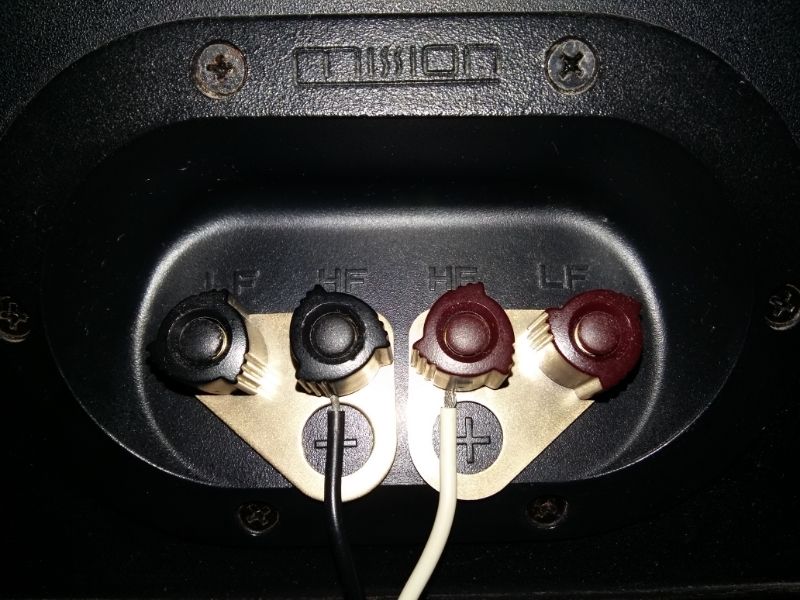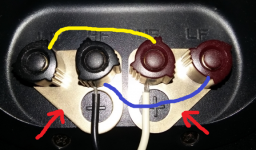I have a Mission bookshelf speaker. I measured it with an ECM8000 mic and below is the result I got.
The crossover point for this specified by manufacturer is 2.8Khz which is also the point where I get a huge dip in frequency response. Do u guys think the crossover is causing this huge dip ? I was thinking of tuning the crossover to remove this dip but I am not sure if this is even possible. Any opinions on this would be greatly appreciated.
An externally hosted image should be here but it was not working when we last tested it.
The crossover point for this specified by manufacturer is 2.8Khz which is also the point where I get a huge dip in frequency response. Do u guys think the crossover is causing this huge dip ? I was thinking of tuning the crossover to remove this dip but I am not sure if this is even possible. Any opinions on this would be greatly appreciated.
Try to find a small cardboard tube in the 50mm or so range and put it to your ear and very close to the tweeter. You'll then be able to tell if it's working.
The test has the look of a crossover than may need a polarity reversal. Or, it was the set up you had for that test. Could you describe it in detail? Mic distance, on or off axis? How was the speaker positioned in the room during your test? etc...
The test has the look of a crossover than may need a polarity reversal. Or, it was the set up you had for that test. Could you describe it in detail? Mic distance, on or off axis? How was the speaker positioned in the room during your test? etc...
Buzzy are you driving the speaker from a amplifier or are you using a headphone outlet ? To test the frequency response set the amplifier with a test tone to give a voltage level equivalent to one watt into a resistor with the same nominal impedance of your speaker.The microphone should be placed at one metre on axis to the speaker and level with the tweeter,so that the measurement follows a standard procedure.
Yes the mic was 1m from the tweeter and on axis and level with the tweeter. I use room eq wizard software to measure. I ran my line out from my soundcard to the av receiver. I have already triple checked to see if any form of EQ is being used in my soundcard or av receiver (all EQ is off). Speaker was placed about 0.5m from front wall in the living room where i am going to use it. I even placed the speaker and tested in another room, but the dip in frequency response was still present.
Was the mic calibration file plugged into the REW S.W.?
Yes. mic calibration file and soundcard calibration file were loaded.
Looks like the tweeter is out of phase. Try swapping the tweeter leads around and test again. You also don't have HFs above 6 kHz, I'd look at the preamp settings for the source of that issue, in addition to testing the tweeter itself again.
Mic is unreliable beyond 5.5Khz. Sry I forgot to mention this. This mic is borrowed from a friend. I have tested another brand speaker (much cheaper) that I have and it measures fine without the huge dip in high frequency response like this.
Last edited:
Looks like the tweeter is out of phase. Try swapping the tweeter leads around and test again. You also don't have HFs above 6 kHz, I'd look at the preamp settings for the source of that issue, in addition to testing the tweeter itself again.
I have to open up the speaker and rewire the tweeter ? This is how I hooked up my speaker.

A little confused as to why it might be out of phase. I bought this speaker from a store and have not tinkered with anything inside before. Does this mean I bought a defective speaker and I did not know it until now ?
I have to open up the speaker and rewire the tweeter ? This is how I hooked up my speaker.

A little confused as to why it might be out of phase. I bought this speaker from a store and have not tinkered with anything inside before. Does this mean I bought a defective speaker and I did not know it until now ?
When a 2-way speaker is out of phase in certain crossover topologies, a strong dip In the FR will will occur in the crossover region
It could be a manufacturing error in assembly that connected the tweeter out of phase. It's not unheard of in the history of store-bought loudspeakers.
Those plates are accessible from the outside. If you can remove them, then add a jumper from the second post to the fourth and another from the first to the third. Then connect to the external speaker wires to the same places (second and third posts).
Those plates are accessible from the outside. If you can remove them, then add a jumper from the second post to the fourth and another from the first to the third. Then connect to the external speaker wires to the same places (second and third posts).
Last edited:
It could be a manufacturing error in assembly that connected the tweeter out of phase. It's not unheard of in the history of store-bought loudspeakers.
First time I have heard of such a thing. Well both speakers have this dip in frequency response. I guess many more owners have this problem too and not know it. I just measured the frequency response out of curiosity, and this is what I found.
The speaker appears to be the Mission M71 model and this is stated to have an average sensitivity of 88db for one watt at one meter.If your mic measurement is accurate then there is a problem with the speakers which could be caused by incorrect xover wiring or a faulty component.An impedance curve is often useful in cases like this as it can show up failures such as shorted turns in a voice coil that a visual inspection could miss.
You could also remove the jumpers and connect the tweeter -ve to the woofer +ve (and vice versa with jumper wires to test whether inverting the phase fixes the issue!
The metal jumpers (arrowed) MUST be removed. Also as a santity check I'd make sure that with the jumpers removed that there is no continuity between the HF and LF +ve terminals, and similary with the -ve terminals. Any short will likely blow the output stage of your amp.
Certainly it looks like the speakers were configured to be able to be bi-wired.
Tony.
The metal jumpers (arrowed) MUST be removed. Also as a santity check I'd make sure that with the jumpers removed that there is no continuity between the HF and LF +ve terminals, and similary with the -ve terminals. Any short will likely blow the output stage of your amp.
Certainly it looks like the speakers were configured to be able to be bi-wired.
Tony.
Attachments
You could also remove the jumpers and connect the tweeter -ve to the woofer +ve (and vice versa with jumper wires to test whether inverting the phase fixes the issue!
The metal jumpers (arrowed) MUST be removed. Also as a santity check I'd make sure that with the jumpers removed that there is no continuity between the HF and LF +ve terminals, and similary with the -ve terminals. Any short will likely blow the output stage of your amp.
Certainly it looks like the speakers were configured to be able to be bi-wired.
Tony.
He could measure them with proper polarity and then reverse it too..
- Status
- This old topic is closed. If you want to reopen this topic, contact a moderator using the "Report Post" button.
- Home
- Loudspeakers
- Multi-Way
- Crossover tuning
